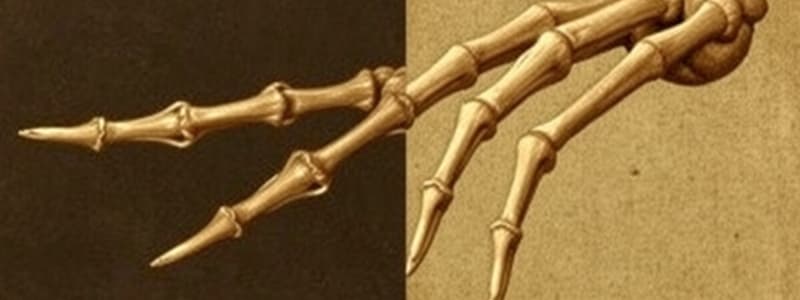Podcast
Questions and Answers
What structural homologies are evident between the forelimbs of hippopotamuses and whales?
What structural homologies are evident between the forelimbs of hippopotamuses and whales?
Both forelimbs exhibit similar bone structures, such as the presence of humerus, radius, and ulna, demonstrating evolutionary relationships.
How does the forelimb of a hippopotamus differ functionally from that of a whale?
How does the forelimb of a hippopotamus differ functionally from that of a whale?
The hippopotamus's forelimb is adapted for walking on land, while the whale's forelimb is modified into a flipper for swimming.
What does the similarity in forelimb structure between hippos and whales suggest about their evolutionary history?
What does the similarity in forelimb structure between hippos and whales suggest about their evolutionary history?
It suggests that hippos and whales share a common ancestor, highlighting the evolutionary transition from land to aquatic environments.
In terms of evolutionary biology, why is the study of structural homology significant?
In terms of evolutionary biology, why is the study of structural homology significant?
What adaptations have the forelimbs of hippos undergone compared to their aquatic relatives?
What adaptations have the forelimbs of hippos undergone compared to their aquatic relatives?
Flashcards are hidden until you start studying
Study Notes
Hippos and Cetaceans Relationship
- Hippos are the closest living relatives of cetaceans (whales, dolphins).
- This relationship is established through structural homology, indicating evolutionary connections.
Structural Homology
- Structural homology refers to the similarity in structure between species due to common ancestry.
- Examination of the forelimbs of hippos and whales reveals significant similarities despite their different adaptations.
Forelimb Comparison
- The forelimb of the hippopotamus has distinct adaptations for terrestrial life, including weight-bearing capabilities.
- The forelimb of the whale is modified for swimming, featuring elongated bones and a flattened shape.
- Both forelimbs share skeletal structures, such as similar bone arrangement (humerus, radius, and ulna), demonstrating their common ancestry.
- Despite functional differences, the underlying bone structure supports the evolutionary link between hippos and cetaceans.
Evolutionary Significance
- The adaptations of both species illustrate how environmental pressures can shape physical traits while retaining anatomical similarities.
- Understanding these relationships helps to track evolutionary history among mammals.
Studying That Suits You
Use AI to generate personalized quizzes and flashcards to suit your learning preferences.




